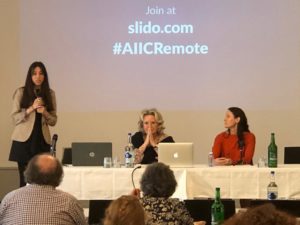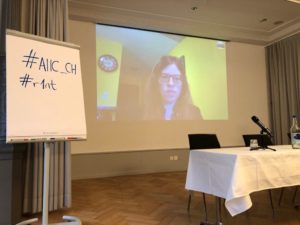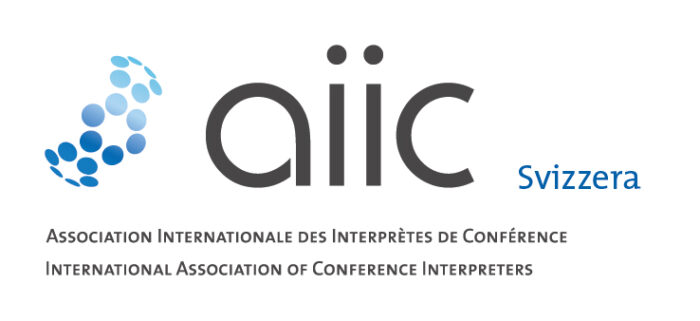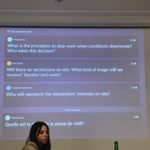December 2019, Amy Brady
Resumee of presentations – Remote interpreting workshop I, 30 November 2019
Sally Bailey, Chief Interpreter, Council of Europe
 The decision to tackle remote interpretation was taken on the basis that we need to be actors of change: if we do not get involved in the introduction of RI, then it will be done without us and the conditions will be worse. Therefore, the Council of Europe (CoE) has been testing a number of RI scenarios. They are not testing proximal interpretation, where the interpreters are located near the meeting room and the audio feed is connected via a direct cable; they are also not testing scenarios where the interpreters are working from home (these were the two scenarios tested and used by the European Union). Instead, their tests have been focused on distal interpretation, where the meeting is happening in one place and the interpreters are located all together but in a different place, and the audio feed is transmitted via the internet and not a direct cable. Only bilingual meetings are covered by the tests.
The decision to tackle remote interpretation was taken on the basis that we need to be actors of change: if we do not get involved in the introduction of RI, then it will be done without us and the conditions will be worse. Therefore, the Council of Europe (CoE) has been testing a number of RI scenarios. They are not testing proximal interpretation, where the interpreters are located near the meeting room and the audio feed is connected via a direct cable; they are also not testing scenarios where the interpreters are working from home (these were the two scenarios tested and used by the European Union). Instead, their tests have been focused on distal interpretation, where the meeting is happening in one place and the interpreters are located all together but in a different place, and the audio feed is transmitted via the internet and not a direct cable. Only bilingual meetings are covered by the tests.
From 13 to 15 November 2019, a test was carried out where interpreters in Strasbourg worked for a bilingual meeting that was taking place in Paris, using an RSI platform. There was a back-up team of interpreters on-site in Paris to take over in case technical problems emerged, and in fact they had to take over three times during the meeting due to technical problems. The conditions for the tests were as close as possible to the requirements contained in the new ISO/PAS 24019 on Remote Simultaneous Interpreting Platforms. The CoE took responsibility for ensuring the health of the interpreters and meeting the necessary technical requirements to avoid acoustic shock. This question of responsibility is one that needs to be properly addressed in any RI scenario.
The interpreters in Strasbourg tested both hard consoles (where the sound goes through the platform and then the regular conference system, and the interpreters use the regular consoles) and soft consoles (using only the platform’s interface, all the controls are located on the computer screen and you click on them with the mouse). It should be noted that treble and bass can be adjusted only on hard consoles, not soft consoles. They also tested a set up where the controls were located on a tactile screen, as well as one where the interpreters had only a pad for on/off/mute and a knob to control the volume. The interpreters reported that they were able to get used to both the tactile screen and using the mouse to control most of the functions, but one thing they found to be absolutely essential was having a knob to control volume. Overall, they judged the audio to be OK.
They tested different screen set ups: one large curved screen inside the booth, and a large screen outside of the booth. There were three visual feeds on each one, showing the chairman, the speaker and the room. Contrary to expectations, the interpreters reported that they found the large curved screen in the booth to be too overwhelming. They also reported that image quality fluctuated a lot and that having to rely on visual feeds all day long was tiring.
During the tests, 4 interpreters were assigned in the bilingual booth instead of 2, as research has not yet been done into the effect that RI will have on the health of interpreters. Moving forward, the main compensation for interpreters working in RI should be a shorter working day, which can be achieved either by means of shorter sessions or reinforced teams.
There are certain meetings that lend themselves to RI. Meetings that will be interpreted remotely need to be well-structured, short in duration, bilingual and not include a lot of interaction among participants. RI should not be used for drafting committees, for instance, or for meetings lasting more than 3 days.
Currently there are meetings that have to be held in English only because interpretation with travel costs is too expensive. RI may lower the cost enough that these meetings can once again be held with interpretation.
The ultimate goal is to be able to offer remote interpretation which takes place in good working conditions and is therefore of good quality, as opposed to the RSI platforms, whose business model is based on low-cost without regard for quality. One of our key challenges in the future will be to remain in control of the interpreter recruitment process, both at institutional level and on the private market.
Amy Brady, UNOG staff interpreter
 The difference between videoconferencing and remote interpretation – during a videoconference, the interpreters are in the same room as the audience and the chair, and a remote participant joins via a VC link to give a presentation. Remote interpretation strictly speaking refers to a situation where the interpreters are not in the room where the meeting is taking place and do not have a direct view of the speakers. They may all be located in the same place (a hub), or they may be spread out in different places, such as at home or in offices.
The difference between videoconferencing and remote interpretation – during a videoconference, the interpreters are in the same room as the audience and the chair, and a remote participant joins via a VC link to give a presentation. Remote interpretation strictly speaking refers to a situation where the interpreters are not in the room where the meeting is taking place and do not have a direct view of the speakers. They may all be located in the same place (a hub), or they may be spread out in different places, such as at home or in offices.
The international organizations have experimented with RI in various ways. The European Council started using it in 2005 for their dinners of heads of state and government. The interpreters would be in in booths in a large tent or a room near the room where the HOSG were meeting. The audio feed was connected via a cable, and there were large screens in front of the booths showing different views of the meeting room and participants. Special working conditions were agreed upon: sessions in remote interpretation were limited to 2.5 hours, as opposed to 4 hours for a regular meeting.
In 2018, the UN set up a joint remote interpretation task force to explore the possibility of having a VC link between the different duty stations so that interpreters in one location could interpret for a meeting in another location. The task force used the European Council model to make plans for a proof of concept test and drew up a cost estimate for it. In the end, it was decided that setting up such a link would be too expensive, and that it would not be used enough to justify the cost, so the proof of concept test never took place and the project was abandoned.
Most recently, DG SCIC tested 4 RSI platforms in order to gain experience upon which to base their input into the new ISO standard on Remote Simultaneous Interpreting Platforms, which is in the drafting stage. The four platforms chosen were selected on the basis of their reported technical specifications. In one part of the test, the interpreters were in regular booths, and in the second part they were at home using a computer. After using each platform, they filled out a questionnaire about their experience. According to the results, the audio quality was judged to be acceptable for short periods of time (between 20 minutes and a half day). The main problem was the difference in sound levels between the audio sources. The image quality was also judged to be acceptable; the main problem was that the image quality fluctuated too much. There were various problems with each platform’s interface; the “handover/switch function” to handover to your remote boothmate, in particular, was judged to be too complicated. Overall, the interface was too prone to human error.
When the interpreters were working from home, they felt alienated from the meeting, easily distracted and had difficulty focusing.
SCIC’s conclusion is that remote interpretation could be used for short, bilingual meetings that normally wouldn’t receive interpretation because it is unaffordable or technically impossible. SCIC could, therefore, use RI to expand the range of services it offers, but they would not use it to replace on-site interpretation.
Kathleen Ratel, AIIC Canada
 There is a difference between an acoustic incident (a one-time incident where the sound gets very loud all of a sudden) and acoustic shock (the symptoms that emerge after such an incident). The symptoms include hearing loss, fatigue, headache, vertigo, nausea, hypersensitivity to sound (hyperacusis). Acoustic incidents can happen during conventional meetings where all participants are on-site (if a speaker touches the microphone or moves it while it is on, or if their headset gets too close to the microphone and causes feedback) as well as in meetings with remote interpretation (mainly because of the difference in sound levels between different sources).
There is a difference between an acoustic incident (a one-time incident where the sound gets very loud all of a sudden) and acoustic shock (the symptoms that emerge after such an incident). The symptoms include hearing loss, fatigue, headache, vertigo, nausea, hypersensitivity to sound (hyperacusis). Acoustic incidents can happen during conventional meetings where all participants are on-site (if a speaker touches the microphone or moves it while it is on, or if their headset gets too close to the microphone and causes feedback) as well as in meetings with remote interpretation (mainly because of the difference in sound levels between different sources).
We need protection against acoustic incidents, such as a limiter, which cuts off the sound if it goes above a certain volume. Limiters can be integrated into the conference sound system, or they can be portable devices, such as PreservEar. It is also possible to use both. However, limiters are not a panacea – they don’t stop feedback at lower levels, which can cause smaller acoustic incidents. The cumulative effects of suffering repeated low-level acoustic incidents have not been studied yet.
Interpreters in Canada have experience with interpreting audioconferences (remote participants give presentation via a telephone link), audioremote interpretation (participants spread out in different locations, interpreters in a studio) and videoconferences. The ones that caused the most injuries were audioconferences because of the difference in sound levels between different sources. Telephone lines transmit sounds in the frequency range of 2500-3000 Hz, which is only 25% of the 15,000 required by the ISO standard. Interpreters therefore have to turn up the volume more in order to interpret, and if there is any feedback it will be dangerously loud. They now have a moratorium on interpreting audioconferences, but they had difficulty introducing it because clients were used to having them interpret telephone calls and couldn’t understand why they started refusing. They still provide interpretation for videoconferences where the sound is transmitted via the internet because the sound levels are more equal and pose less of a problem.
The platforms are just one link in the chain – even if they meet ISO standards, the participants speaking at the other side of the link still need to have proper equipment in order for sound to be good enough for interpretation, such as a cabled microphone (not wireless, no laptop microphone). We therefore need to continue awareness-raising with clients to make sure that they use proper equipment. We need to tell them about the impact that improper microphones can have on the health of interpreters, and on the quality of interpretation.
You will find more information and guidelines in the section “RSI – remote simultaneous interpreting” here.
Don’t miss our resumee of the 2nd RSI workshop
Photo gallery
Programme
| 10:30 – 11:00 | Coffee and registration |
| 11:00 – 11:10 | Opening of activities (RawdhaCammoun-Claveria – AIIC) |
| 11:10 – 11:45 | Introduction to remote interpretation
Remote interpreting tests at the UN, SCIC & European Council |
| 11:45 – 12:30 | Remote interpreting tests at the Council of Europe (Sally Bailey, Chief Interpreter, Council of Europe) |
| 12:30 – 13:15 | Discussion, questions and answers |
| 13:15 – 14:45 | Lunch |
| 14:45 – 15:30 | Acoustic shock (Kathleen Ratel, AIIC Canada) |
| 15:30 – 16:00 | An overview of remote interpreting platforms (Amy Brady – UNOG) |
| 16:00 – 17:00 | Remote interpreting case studies |
| 17:00 – 17:15 | Wrap-up and takeaways |

























